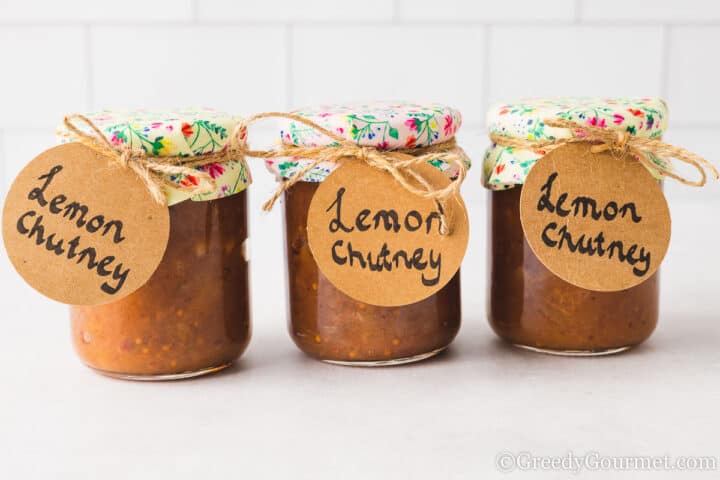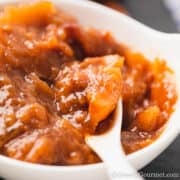Homemade lemon chutney is a zesty, tangy, taste bud tingling delight, with a depth of flavor that is truly sensational!

What's more, this subtly spiced condiment is wonderfully versatile. There are so many dishes and snacks that are elevated with the addition of a few spoonfuls of this luscious chutney.
So, are you ready to make chutney? Let's get cooking!
Why you'll love this lemon chutney recipe
- Homemade chutney has a long shelf life and is ideal to eat all year round
- It's packed with fresh fruit and veg and is fat-free
- Extremely versatile – can be used as a side dish, dip, spread and as a fabulous flavor enhancer
- Vegan and vegetarian friendly
- A simple, one-pot recipe
- Makes for an exceptional homemade gift to give to friends and family


CHUTNEY EQUIPMENT YOU NEED
Check out the ultimate list to chutney making equipment. You actually don't need that much and most of the items are quite affordable!
Making your own preserves is a great and satisfying hobby. Giving the gift the lovely food to your friends and family are especially rewarding!
Top Tip
Stir your chutney frequently throughout the simmering process.

What to pair with chutney
Meat or fish
Lemon chutney pairs wonderfully well with anchovies, beef, chicken, lamb, oily fish or smoked fish.
Cheeseboard
Cheese and chutney is a delightful double act! Serve this lemon chutney with your favorite cheeses (goat’s cheese would be delicious) and crackers – good luck resisting!
Nuts or nut butter
Any chutney pairs really well with a handful of nuts – anything like pistachios, cashews, almonds, pecans, walnuts or macadamias would be fabulous.
You could also spread macadamia nut butter and chutney on your favorite crackers for an irresistible snack.
Curry
Chicken korai is a wonderfully fragrant slow cooked chicken curry recipe that really suits the zesty flavors of lemon chutney. My easy chicken curry is another great option, particularly if simplicity is what you're looking for.
Another great option, for those who like a bit of sweet and sour, is a chicken pathia.
Lemon chutney also pairs perfectly well with fish curries. Try this fish korma recipe.
Would you like to save this?
Dessert
This chutney doesn't just have to pair with a savory dish. Try a spoonful or two with a chocolate or white chocolate dessert.
Wine pairing
I would recommend a dry white wine to pair with this zesty lemon chutney.
Something like a cool crisp Riesling would be perfection. You could also go for a fruity California Chardonnay or a Pinot Noir.
If you prefer red wine, opt for a Shiraz or a Chilean Merlot – fruity, full-bodied and perfect with savory/fruity flavors.

Variations to this recipe
Extra fruit
Make up your own divine combinations! Swap 50% of the lemon in the recipe below with one of the following fruits:
- Blueberries
- Fresh coconut
- Lime
- Black currants
- Raspberries
- Strawberries
Other flavors you can play with
Add an extra dimension of garlic flavour to your lemon chutney with any of the following:
- 5cm (2in) fresh ginger root, grated
- 50g (½ cup) almonds, chopped or slivered
- 3 star anise
- 1 teaspoon coriander seeds
- 1 cup sugar of your choice in place of brown sugar
- 1 cup white wine vinegar
- 1 chili, finely chopped
- 1 teaspoon chili powder
- ½ teaspoon ground coriander seeds
- ½ teaspoon ground cumin
- 1 tablespoon dill, finely chopped
- 1 tablespoon fresh mint, finely chopped
- 5 juniper berries
- 5 cardamom pods, crushed
- 1 orange, juice and rind
- ½ teaspoon fresh rosemary, chopped [or less!]
- ½ teaspoon fresh thyme, chopped [or less!]
- Pinch of saffron
Popular substitutions
- Many food writers sing the praises of the Meyer lemon – including the legendary Laurie Colwin. You can easily make meyer lemon chutney – meyer lemons are a cross between lemons and mandarins and produce a sweeter, less sour flavor.
- Brown sugar is best with this recipe. However, you can use demerara sugar or golden caster sugar for a caramel undertone.
- You can replace the apple cider vinegar with white wine vinegar.

Top tips for amazing chutney
- Preparation is key – do all the food prep before you start cooking. That way you can cook all the ingredients with precision and care.
- Use quality ingredients. Avoid lemons that are under or over ripe, and make sure they are free from blemishes.
- Freshly ground spices are more flavourful and fragrant.
- Always use a stainless steel pan when making chutney. Other materials don't react well to the vinegar in the recipe.
- Cut the fruit and vegetables into even-sized pieces. That way you'll achieve a wonderful texture to your chutney.
- Don't be tempted to improvise. Stick to the recipe below and you'll end up with the perfect taste and texture.
- Regularly stir your chutney, particularly towards the end of the cooking process. This helps with the flavor and texture, but also prevents the mixture from sticking to the bottom of the pan.
- Always be sure to sterilize your chutney storage jars. This stage is very important and shouldn't be overlooked.
- Patience is key! This chutney needs time for the flavors to fully mature. Give this chutney at least six weeks – six months would be even better!

Why do I need to marinate the lemons?
Leaving the lemon pieces overnight in a bowl with a sprinkle of salt allows them to soften. It also removes some of the bitterness from the lemon, giving you a more flavorful chutney.
What's the difference between chutneys and pickles?
They are very similar in many ways – both are preserves that use vegetables, fruits, spices and vinegar. There are a few key differences, such as the size of the pieces, the overall texture, the cooking process and the overall taste.
For a full explanation of the difference between chutney and pickles, take a look at our guide to Chutney Vs Pickle.
How do you know when chutney is ready?
The classic chutney texture is thick and silky. The best way to test it is to use your spoon to draw a channel in the chutney. If it takes a few seconds for the vinegar to run back into the channel, then it’s ready.
If the vinegar runs into the channel straight away, it needs a little more time. Put it back on the heat and let it simmer for a few more minutes. Then, try the test again.
Do I need to sterilize the jars before storing chutney?
Yes! This is a very important part of the chutney making process. Sterilizing jars not only extends the shelf life of your homemade chutney, but it makes it safe to eat.
Check out our complete guide on How to Sterilize Jars for step by step instructions.
How do I store lemon chutney?
Keep your chutney in a sterilised airtight jar, store it in a cool dry place and it’ll stay fresh for over a year.
Once opened, how long does it keep?
Once you’ve opened your chutney, refrigerate it. It’ll stay fresh for around 2 months.

More amazing chutney recipes
When it comes to home cooking, chutney making is as good as it gets. So, with that in mind, here's some ideas for more wonderful chutney recipes for you to get hooked on:
- Papaya chutney – papayas are an underused fruit with plenty of flavor. It’s an excellent ingredient when used to make a chutney, which makes this recipe well worth making
- Mrs Ball’s chutney – a South African favorite, Mrs Ball’s chutney is a wonderful mild chutney that is the perfect mixture of sweet and savory. Made of several fruits, mainly plum, it’s great with turkey, vegetables and especially cheese
- Orange chutney – a zesty chutney with plenty of charm
- Marrow chutney – a moreish vegetable chutney with a pleasant kick
- Plum Chutney – this spiced plum chutney goes down great at Christmas time
📖 Recipe

Lemon Chutney
- Total Time: 1 hour 15 minutes
- Yield: 6 x 200g jars, 30g per portion, 40 portions 1x
- Diet: Vegan
Description
Zesty and vibrant, this lemon chutney recipe adds a burst of citrusy goodness to your meals. It's a tangy condiment that complements a variety of dishes!
Ingredients
- 900g (2lbs) lemons
- 25g (1 ½ tbsp) salt
- 450g (1lb) onions
- 450g (1lb) brown sugar
- 125g (½ cup) pitted dates, chopped
- 15g (1 ½ tbsp) mustard seeds
- 3g (1 tsp) ground ginger
- 500ml (2 cups) apple cider vinegar
Instructions
- Wash the lemons then halve them. Remove the pips and slice thinly.
- Put the cut lemons into a bowl and evenly sprinkle them with salt. Proceed to cover the bowl with a cloth and let it sit for a minimum of 6 hours, allowing the marination process to take place. You can leave it overnight if desired, but do not exceed that time.
- Tip the lemon mixture along with the rest of the ingredients in a preserving pan.
- Stir the contents over a medium heat until the sugar has dissolved.
- Crank up the heat and let the mixture reach a boil, then reduce to a steady simmer.
- Continue to cook uncovered for 45 minutes or until the chutney has thickened. Do give it a stir every now and then to prevent the food from sticking to the bottom of the pan.
- Spoon into hot, sterilised jars. Seal and then let it cool down.
- Label the jars, then let the chutney mature for at least a month before opening. Enjoy!
Notes
- For a citrusy variation, you can swap out 50% of the lemons with oranges.
- Prep Time: 15 minutes
- Cook Time: 1 hour
- Category: Condiment
- Method: Boil
- Cuisine: Indian
Nutrition
- Serving Size:
- Calories: 67
- Sugar: 14.1 g
- Sodium: 247 mg
- Fat: 0.2 g
- Saturated Fat: 0 g
- Trans Fat: 0 g
- Carbohydrates: 16.8 g
- Fiber: 1.1 g
- Protein: 0.5 g
- Cholesterol: 0 mg





Make my day! - Share your thoughts...